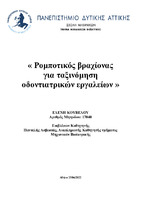| dc.contributor.advisor | Asvestas, Pantelis | |
| dc.contributor.author | Κούβελου, Ελένη | |
| dc.date.accessioned | 2022-08-05T09:02:43Z | |
| dc.date.available | 2022-08-05T09:02:43Z | |
| dc.date.issued | 2022-07-21 | |
| dc.identifier.uri | https://polynoe.lib.uniwa.gr/xmlui/handle/11400/2760 | |
| dc.identifier.uri | http://dx.doi.org/10.26265/polynoe-2600 | |
| dc.description.abstract | Η παρούσα εργασία αφορά στην κατασκευή ενός ρομποτικού βραχίονα που στόχο
έχει να αναγνωρίζει και να ταξινομεί πέντε οδοντιατρικά εργαλεία, από ένα σετ
σφραγίσματος, σε συγκεκριμένες θέσεις. Οι περισσότεροι οδοντίατροι εργάζονται
μόνοι τους, χωρίς τη βοήθεια νοσοκόμων. Με αφορμή τη συνθήκη αυτή, ήθελα να
δημιουργήσω έναν βοηθό, όπου θα παίρνει τα εργαλεία από τον κλίβανο και θα τα
ταξινομεί σε συγκεκριμένες θέσεις. Για την κατασκευή, βρέθηκε και επεξεργάστηκε
τρισδιάστατο σχέδιο, το οποίο και εκτυπώθηκε στον τρισδιάστατο εκτυπωτή της
σχολής. Αρχικά έγινε μια πρόχειρη εκτύπωση για να ελεγχθούν τα μεγέθη και οι
αποστάσεις και στη συνέχεια προχωρήσαμε σε κανονική εκτύπωση (fine printing),
όπου τα κομμάτια βγήκαν με λιγότερες ατέλειες. Μελετήθηκε ο βέλτιστος τρόπος
λείανσης στην αρχική πρόχειρη εκτύπωση και στη συνέχεια η τεχνική που
επιλέχθηκε, εφαρμόστηκε και στην κανονική εκτύπωση. Τα κομμάτια, λοιπόν,
λειάνθηκαν και συναρμολογήθηκαν, ώστε να δημιουργηθεί ο σκελετός του βραχίονα.
Σε αυτό το στάδιο μελετήθηκε και ο τρόπος που έγινε η λείανση και η στεγανοποίηση
των τμημάτων του ρομποτικού βραχίονα, καθώς η βάση του θα ακουμπά στο τραπέζι
του οδοντιάτρου και περιέχει ηλεκτρονικό κύκλωμα. Ακόμα, για να γίνει η κίνηση
του βραχίονα, δημιουργήθηκε πρόγραμμα σε python για τον έλεγχο τεσσάρων
σερβοκινητήρων, μέσω της πλακέτας Arduino uno. Για την ταξινόμηση των
αντικειμένων χρησιμοποιείται κάμερα, η οποία καθοδηγεί τον βραχίονα, σύμφωνα με
εικόνες των εργαλείων που λάβαμε πριν την ταξινόμηση. Η διαδικασία αυτή γίνεται
πάντα κάτω από τις ίδιες συνθήκες φωτισμού, ώστε οι φωτογραφίες να λαμβάνονται
πάντα με τον ίδιο τρόπο, χωρίς να θολώνει η εικόνα. | el |
| dc.format.extent | 62 | el |
| dc.language.iso | el | el |
| dc.publisher | Πανεπιστήμιο Δυτικής Αττικής | el |
| dc.rights | Αναφορά Δημιουργού - Μη Εμπορική Χρήση - Παρόμοια Διανομή 4.0 Διεθνές | * |
| dc.rights | Attribution-NonCommercial-NoDerivatives 4.0 Διεθνές | * |
| dc.rights.uri | http://creativecommons.org/licenses/by-nc-nd/4.0/ | * |
| dc.subject | Ρομποτικός βραχίονας | el |
| dc.subject | Οπτική καθοδήγηση | el |
| dc.subject | Arduino uno | el |
| dc.subject | Python | el |
| dc.subject | Σερβοκινητήρες | el |
| dc.subject | Οδοντιατρικά εργαλεία | el |
| dc.title | Ρομποτικός βραχίονας για ταξινόμηση οδοντιατρικών εργαλείων | el |
| dc.title.alternative | Robotic arm for classifying dental tools | el |
| dc.type | Διπλωματική εργασία | el |
| dc.contributor.committee | Glotsos, Dimitris | |
| dc.contributor.committee | Kostopoulos, Spiros | |
| dc.contributor.faculty | Σχολή Μηχανικών | el |
| dc.contributor.department | Τμήμα Μηχανικών Βιοϊατρικής | el |
| dc.description.abstracttranslated | This project is about the construction of a robotic arm that aims to recognize and
classify five dental tools from a filling set in particular positions. Most dentists work
on their own, without the help of nurses. Taking this condition into consideration, I
wanted to create a helper, which will take the tools from the furnace and classify them
in particular positions. For the construction, a 3D design haw been found and
processed, which was printed in the school 3D printer. Initially a draft printing was
done to check the measures and distances and them we moved to the fine printing, in
which less flaws were found. The best way to smooth was studied in the initial print
and the chosen technique was applied to the fine printing. The pieces then, were made
smooth and put together to create the body of the arm. At this stage the way with
which the parts of the robotic arm were made smooth and dry was shielded as its base
will touch the dentist’s table which has an electrical circuit. Moreover, the movement
of the arm was created in python to control the four servo motors, through the
Arduino uno plaquette. To classify the objects a camera is used, which leads the arm
according to the tool pictures we received before classification. This procedure is
always done under the same light circumstances so that the pictures are always
received in the same manner, without blurring. | el |


